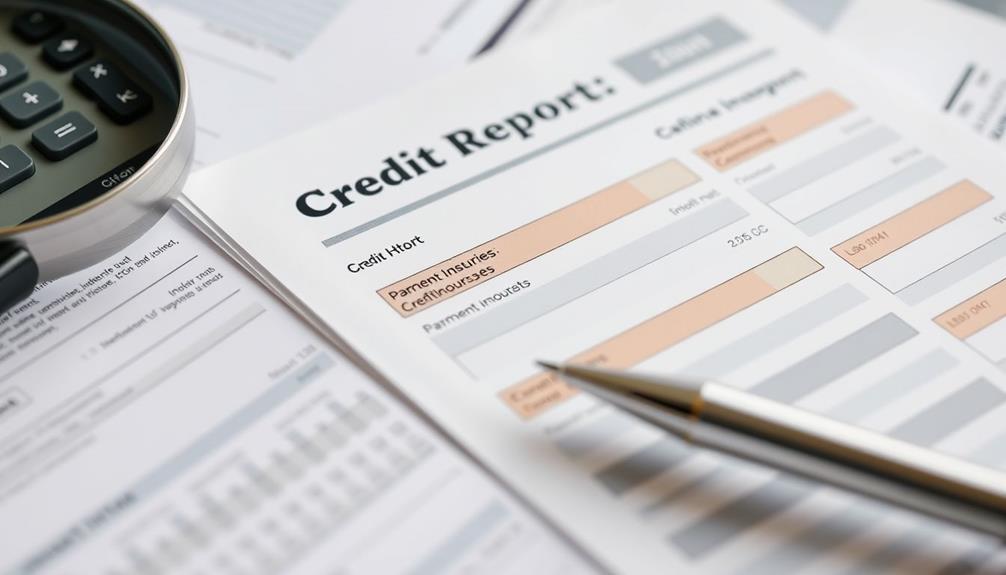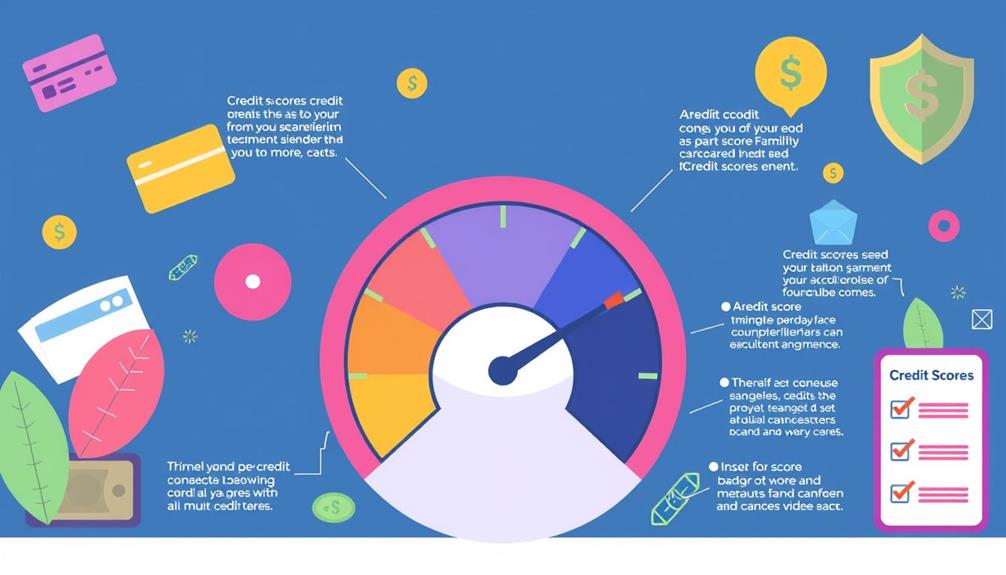Understanding your credit score is vital for achieving financial goals. Scores range from 300 to 850, affecting loan eligibility and interest rates. Key factors include payment history, credit utilization, and the length of your credit history. To improve your score, pay bills on time, keep your credit utilization below 30%, and limit new credit inquiries. Regularly checking your credit report helps you spot errors and track progress. It's also important to know common credit myths that could misguide your efforts. Explore how these elements tie together to enhance your credit health and open doors to new opportunities.
Key Takeaways
- Credit scores range from 300 to 850, with higher scores improving loan eligibility and interest rates.
- Timely bill payments constitute 35% of your credit score, making consistent payments crucial.
- Keep credit utilization below 30% by managing balances and paying off bills on time.
- Regularly check your credit report for errors and monitor your score to maintain healthy credit habits.
- Myths, such as self-checks affecting scores or closing old accounts improving scores, can mislead credit management efforts.
Importance of Credit Scores

Credit scores play an essential role in your financial life, acting as a barometer of your creditworthiness. These scores, ranging from 300 to 850, greatly influence your loan eligibility and the interest rates you'll face. A higher credit score opens up better financial opportunities, like lower interest rates on loans and credit cards, potentially saving you thousands over your lifetime.
Understanding the impacts of credit card trends can help you manage your finances more effectively.
Payment history is key, accounting for 35% of your score. Timely bill payments can boost your credit score, while poor credit scores can have far-reaching consequences. Not only can they hinder your ability to secure loans, but they can also impact rental housing applications, car rentals, and even life insurance eligibility.
This highlights the broad implications your credit score has on your overall financial health.
Maintaining a good credit score is crucial for achieving your financial goals. It can affect everything from job prospects to insurance premiums. By understanding the importance of your credit score, you can take proactive steps to improve it, ensuring that you're well-positioned to seize financial opportunities as they arise.
Key Factors Affecting Scores

Understanding the key factors that influence your credit score is essential for managing your financial health. Here's a breakdown of the main elements that affect your score:
| Factor | Percentage Impact |
|---|---|
| Payment History | 35% |
| Credit Utilization | 30% |
| Length of Credit History | 15% |
| Types of Credit | 10% |
| New Credit Inquiries | 10% |
Your payment history is vital; timely payments can help you avoid negative marks from late payments. Credit utilization, representing 30% of your score, should ideally be kept below 30% of your total available credit to optimize your creditworthiness. The length of your credit history contributes 15% to your score, so maintaining old accounts can positively impact this factor.
Moreover, the types of credit you have—like a mix of credit cards and installment loans—account for 10% of your score, emphasizing the importance of diverse credit management. Finally, new credit inquiries affect 10% of your score; limiting new credit applications can help prevent drops due to hard inquiries. Focus on these factors to improve your credit score effectively!
How to Check Your Credit

Monitoring your credit is essential for maintaining your financial health. You're entitled to one free credit report each year from Equifax, Experian, and TransUnion. This gives you a chance to check your credit for errors and inaccuracies. When you review your credit report information, look closely at your payment history and credit utilization, as these factors greatly affect your score.
Incorporating mindful eating practices in your financial habits can lead to better decision-making and improved financial well-being.
To keep track of your credit score regularly, consider using reputable credit monitoring services, many of which banks offer for free. These tools let you monitor your score and alert you to any notable changes. When you check your credit, make sure to use soft inquiries, as hard inquiries can impact your score for up to two years.
If you find any inaccuracies while reviewing your reports, don't hesitate to dispute them. Addressing errors can help improve your credit over time.
Improving Payment History

Improving your payment history starts with making timely bill payments, as they play a big role in your credit score.
Regularly monitoring your financial habits can also help you identify areas for improvement, ensuring that you don't miss any payments. You can automate payment reminders to help you stay on track and avoid late fees.
If you have past-due accounts, addressing them can boost your score over time, so it's worth taking action.
Additionally, understanding how factors like Gold IRA scams can impact your financial decisions may lead to better overall credit management.
Timely Bill Payments
Timely bill payments play an essential role in shaping your credit score and overall financial health. They account for 35% of your FICO credit score, making them the most significant factor in determining your creditworthiness. Late payments can linger on your credit report for up to seven years, causing significant damage to your score and making it tougher to secure loans or credit in the future.
Additionally, just as diversifying your investments can reduce risk exposure in your retirement portfolio, maintaining a strong payment history helps mitigate the risks associated with poor credit health, ultimately leading to more favorable credit terms. For those considering financial decisions, understanding the risks involved with investment choices is vital.
To guarantee you make timely bill payments, consider setting up automatic payments or reminders. This strategy can drastically reduce the risk of missed payments, helping you maintain a strong payment history. Consistently making on-time payments is key to gradually improving your credit score, which positively influences your credit health.
Additionally, utilizing services like Experian Boost can enhance your payment history by allowing you to receive credit for on-time utility and streaming service payments. By prioritizing timely bill payments, you empower yourself to build a solid financial foundation and increase your chances of obtaining favorable credit terms in the future.
Automate Payment Reminders
Automating payment reminders is a smart way to guarantee your bills get paid on time, further supporting the positive payment history that makes up a notable portion of your credit score. By setting up automatic payments for recurring bills, you can reduce the risk of missing deadlines, which is essential since late payments can linger on your credit report for up to seven years.
Additionally, implementing organized systems for your finances can mirror the meticulous planning needed in other areas, such as when choosing a home cleaning service to maintain a clean living environment.
Many banks and financial institutions offer free tools and apps that let you schedule payment reminders or automate payments, making it easier to manage your financial obligations. By consistently making on-time payments through these automated reminders, you demonstrate responsible credit management, a key factor in improving credit scores.
Additionally, utilizing payment alerts helps you keep track of upcoming due dates, ensuring you avoid late fees and penalties that could negatively impact your credit standing.
Address Past-Due Accounts
Addressing past-due accounts can considerably impact your credit score, as late payments often linger on your report for up to seven years. Tackling these accounts is essential for improving your payment history and overall credit profile. Start by reviewing your credit reports to identify which debts need your attention.
| Action | Benefits |
|---|---|
| Pay Off Past-Due Accounts | Gradually improve credit score |
| Set Up Automatic Payments | Guarantee future bills are paid on time |
| Maintain On-Time Payments | Enhance payment history consistency |
When you prioritize and pay off these past-due accounts, you'll begin to see your credit score improve, though it may take some time to reflect these changes. A consistent pattern of on-time payments can greatly enhance your score—remember, 35% of your FICO Score is based on payment history. Additionally, setting up automatic payments or reminders can help you avoid new late payments, further aiding in your credit repair efforts. By addressing negative information, you pave the way for a healthier financial future.
Managing Credit Utilization

Credit utilization plays an important role in shaping your overall credit score, accounting for 30% of your FICO Score. To maintain a good credit score, aim to keep your credit utilization ratio below 30%. This ratio represents your current credit card balances in relation to your total credit limits. When you have higher utilization, it can negatively impact your credit rating.
Setting clear objectives for your credit management, such as tracking your spending and payment habits, can enhance your financial health and credit score goal tracking pitfalls.
One effective way to improve your credit utilization is by paying your bills on time and in full each month. By doing this, you'll reduce your credit card balances, which directly helps lower your utilization ratio.
Additionally, consider requesting higher limits on existing accounts or opening new ones. This can boost your total credit limit, allowing you to maintain a lower utilization percentage without increasing your debt.
Regularly monitoring your credit is also essential. Keep an eye on your credit card balances and adjust your spending habits if necessary.
By actively managing your credit utilization, you can greatly improve your credit score and demonstrate responsible credit behavior to potential lenders.
Strategies for Credit Improvement

Improving your credit score involves a combination of smart strategies that build on the foundation of good credit utilization habits.
First, prioritize timely payments, as they account for 35% of your score. Consider setting up automatic payments or reminders to guarantee you never miss a due date. Consistency in managing your credit can also enhance your reputation as a responsible borrower, which reinforces trust with lenders building a strong reputation.
Next, keep your credit utilization below 30% of your total credit limit, since this factor contributes 30% to your score. Regularly monitor your credit card balances and pay off existing debts to stay within this limit.
Maintaining old accounts is vital for improving your credit history, which makes up 15% of your score. Keeping unused accounts open can enhance your credit age.
Additionally, limit new credit inquiries; multiple applications can negatively impact your score and account for 10% of it. Only apply for new credit when absolutely necessary.
Impact of Hard Inquiries

Understanding the impact of hard inquiries is vital for managing your credit score effectively. Hard inquiries occur when lenders check your credit report during the loan or credit application process.
While one hard inquiry may only decrease your credit score by a few points, multiple inquiries in a short timeframe can greatly lower it. This can signal to lenders that you might be a higher risk, affecting their lending decisions.
Additionally, just as diversifying your retirement portfolio is important for financial stability, maintaining a balanced credit profile can help you secure better loan terms. To learn more about managing investments, consider exploring investment strategies in precious metals.
To improve your credit score, it's essential to limit new credit applications. Only apply for credit when necessary, and do your research beforehand to gauge your likelihood of approval.
Understanding Credit Reports

Your credit report serves as a thorough snapshot of your financial behavior, detailing everything from personal information to your payment history and account balances.
It's vital to understand that this document greatly impacts your credit scores and overall creditworthiness. Just as regular screenings are important for detecting health issues, discussing personal risk factors with your financial advisor can help you better manage your credit.
Here are four key components of your credit report:
- Personal Information: This includes your name, address, Social Security number, and employment history.
- Credit Accounts: Details of your existing credit accounts, including credit cards and loans, are listed here.
- Payment History: This section outlines your payment record, showing whether you've made payments on time or had late payments.
- Inquiries: Any inquiries made into your credit report, both hard and soft, will also be noted.
Since errors in credit reports can negatively affect your credit scores, it's important to regularly monitor for errors.
You're entitled to one free credit report annually from each of the three major bureaus—Equifax, Experian, and TransUnion. If you spot inaccuracies, don't hesitate to dispute with the credit bureau to guarantee your credit history remains accurate and reliable.
Monitoring Your Credit Progress
Monitoring your credit progress is just as important as understanding your credit report. Regularly checking your credit scores from Equifax, Experian, and TransUnion helps you identify errors and understand fluctuations in your credit health. You're entitled to one free credit report annually from each bureau, which is an excellent opportunity to track score changes.
Using credit monitoring services can keep you informed about your credit status. Many banks offer these services for free, allowing you to set alerts for significant changes in your credit reports, like new accounts or improved credit utilization. This can motivate you to maintain good credit habits.
| Action | Benefit |
|---|---|
| Regularly check reports | Identify errors and dispute inaccuracies |
| Set alerts for changes | Stay updated and track score changes |
| Use monitoring services | Protect against identity theft |
Tracking your credit progress helps you see the positive impact of timely payments and reduced debt on your credit scores. Remember, proactive monitoring is key to maintaining your financial health.
Common Credit Score Myths

Credit score myths can lead to confusion and poor financial decisions. It's vital to debunk these misconceptions so you can improve your credit score effectively. Here are some common credit myths to be aware of:
- Self-checks hurt your score: Checking your own credit score is a soft inquiry and doesn't impact it. It's important to regularly monitor your credit, including understanding IRA for Gold as a financial strategy that can affect overall financial health.
- Closing old accounts helps: Closing old accounts can shorten your credit history and increase your credit utilization, which may lower your score.
- Only loans matter: Credit scores consider various factors, including credit cards and utility payments, not just loans.
- Credit repair companies guarantee increases: No company can promise a specific score boost; your score depends on your credit behavior and report accuracy.
Understanding these credit myths is vital in managing your credit report wisely.
Frequently Asked Questions
What Are 3 Things You Can Do to Improve Your Credit Score?
To improve your credit score, pay your bills on time, keep your credit utilization under 30%, and regularly check your credit reports for errors. These actions can enhance your overall creditworthiness greatly.
What Is the Fastest Way to Boost Credit Score?
To boost your credit score quickly, pay down credit card balances to keep your utilization below 30%. Also, guarantee timely payments on all bills to positively impact your payment history and score.
What Are the 5 Levels of Credit Scores?
You should know the five credit score levels: Poor (300-579), Fair (580-669), Good (670-739), Very Good (740-799), and Excellent (800-850). Higher scores mean better creditworthiness and access to favorable loan terms.
What Is #1 Factor in Improving Your Credit Score?
The number one factor in improving your credit score is your payment history. You've gotta make timely payments consistently; one late payment can hurt your score considerably. Stay diligent to maintain a strong payment record.
Conclusion
In the grand saga of your financial journey, mastering your credit score is like wielding a magic wand that opens doors to unimaginable opportunities! By understanding its importance and tackling those pesky factors head-on, you can transform your credit score from a mere number to a powerful ally. Don't let myths hold you back—take charge, monitor your progress, and watch your financial prospects soar to heights you never thought possible! Your dream life is just a score away!










